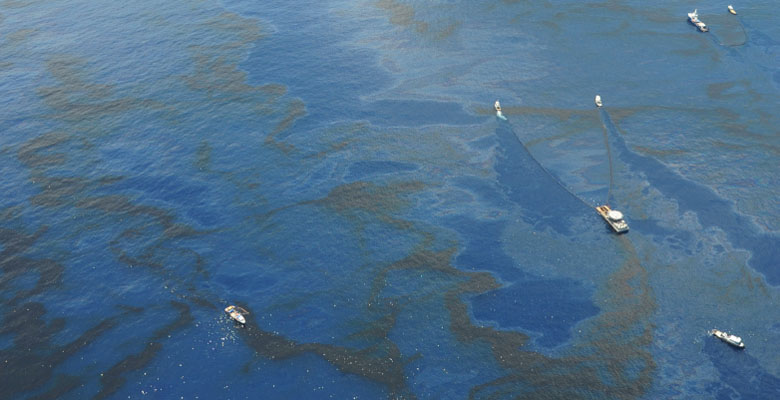
Deepwater hits the air
Findings at the catastrophic oil spill site have implications beyond the Gulf
Scientists used NOAA ‘s WP-3D aircraft to measure the effect of the Deepwater Horizon oil spill on air quality.
The Science
At the spill site, researchers discovered a new set of chemicals that contributes to diminished air quality — chemicals that also exist in urban environments.
But this is not what the scientists observed. “We detected particles being formed, but over a much wider area,” said de Gouw. “So that was a big surprise.”
The scientists realized that other compounds, aside from the highly volatile components of the oil, had to be contributing to the air pollution. Because they recorded organic aerosols over a broad area, they concluded the heavier, less-volatile compounds that are slower to evaporate were also forming aerosols.
These chemical instigators of air pollution exist elsewhere—not just in catastrophic oil spills, de Gouw said. The oil was not a thick sludge but more similar to the highly refined oil that is used in cars or factories, he said. That means the same heavier compounds that contributed to air pollution over the Gulf Oil Spill also contribute to air pollution in urban environments.
But these compounds are not measured in most air-quality monitoring programs designed to capture the conventional contributors to poor air quality. “This chemistry could be a very important source of aerosols in the urban United States and elsewhere,” de Gouw said. “What we learned from this study will help us to improve air quality understanding and prediction.”
material. Organic aerosols are linked to asthma, cardiovascular disease and even premature death. But scientists only know the origin of a small fraction of the organic aerosols. “The problem has been that we know there are more organic aerosols than we can account for,” de Gouw said. “So there is a lot of discussion in the literature on where this organic material comes from.”
The team’s research on the air quality impacts of the oil spill shed new light on this mystery. In early June, a team of scientists from NOAA and CIRES arrived at the scene of the spill to assess how much of the oil was evaporating into the atmosphere, and whether this oil was a concern for air quality. The team flew for about 14 hours directly over and downwind of the oil spill, and instruments aboard the research aircraft measured many types of air pollution particles, including organic aerosols, and the chemicals that make them.
Based on the current scientific understanding, de Gouw and his colleagues knew where they expected to see the aerosols: exactly where they saw the most volatile components of the oil evaporate, in a narrow plume downwind from the spill site.
By Jane Palmer
When a team of researchers from CIRES and NOAA raced to the scene of the BP Deepwater Horizon oil spill to assess the disaster’s impact on air quality, they found more than they expected.
A significant fraction of the oil that surfaced had evaporated. Also, measurements taken onboard the NOAA WP-3D aircraft revealed that organic aerosols—a form of air pollution—formed from the oil vapors. Aside from the common culprits that create organic aerosols, the researchers discovered a new set of chemicals that contributes to diminished air quality—chemicals that also exist in urban environments.
“It was very clear that the aerosols were formed from compounds not currently measured,” said CIRES Fellow and research scientist Joost de Gouw. Discovering these previously unknown sources of aerosols could improve scientists’ understanding of air pollution, said de Gouw. “This really shows that we need to start paying more attention to these compounds,” he said.
Aerosols are microscopic particles suspended in the air—in polluted U.S. cities about half of the air pollution particles consists of organic



